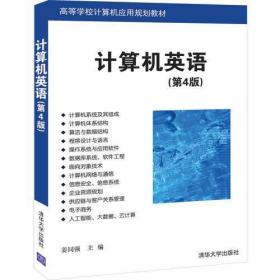
计算机英语(第4版)
二手书,此书是一本无赠品和附件,非套装,购买套装请联系客服
¥ 11.3 1.9折 ¥ 59 八五品
库存53件
山东济南
认证卖家担保交易快速发货售后保障
作者姜同强
出版社清华大学出版社
出版时间2020-05
版次4
装帧其他
货号9787302532187
上书时间2024-09-18
- 在售商品 暂无
- 平均发货时间 8小时
- 好评率 暂无
- 最新上架
商品详情
- 品相描述:八五品
图书标准信息
- 作者 姜同强
- 出版社 清华大学出版社
- 出版时间 2020-05
- 版次 4
- ISBN 9787302532187
- 定价 59.00元
- 装帧 其他
- 开本 16开
- 纸张 胶版纸
- 页数 332页
- 字数 535千字
- 【内容简介】
-
直接阅读外文技术资料和文献是每位计算机技术人员和研究人员必须具备的一种能力。《计算机英语(第4版)》旨在使学生及专业人员能够熟悉并掌握计算机方面的基本专业英文词汇,了解科技英语的基本认知规律,并提高在计算机专业英文文献方面的阅读能力。
《计算机英语(第4版)》共分为21章,汇集了计算机技术各方面的内容,包括计算机硬件、软件、网络与通信、计算机应用技术及人工智能、大数据、云计算等。《计算机英语(第4版)》内容和专业词汇的涵盖面广,选择的文章具有代表性和新颖性,其中的阅读材料对近10年来产生的一些新技术进行了详细介绍,从而使教师在选择教学内容方面有较大的灵活性。
《计算机英语(第4版)》适合于计算机科学与技术专业、软件工程专业、信息管理与信息系统专业、电子商务专业,以及其他相关专业的本科生、研究生作为计算机专业英语课程的教材,对从事与计算机相关工作的专业技术人员提高计算机专业外文文献的阅读能力也有一定的帮助。 - 【目录】
-
Chapter 1 Computer System
Overview 1
1.1 Digital Computer 1
1.2 Data Types 2
1.3 The Evolution of Computers 3
1.4 Types of Computers 4
Technical Notes to the Text 5
Word Bank to the Text 7
Exercises 10
Chapter 2 Computer System Organization 13
2.1 Computer Organization Introduction 13
2.2 System Buses 14
2.2.1 Address Bus 14
2.2.2 Data Bus 14
2.2.3 Control Bus 14
2.3 CPU Organization 15
2.3.1 Register Set 15
2.3.2 Arithmetic Logic Unit 15
2.3.3 Control Unit 15
2.4 Memory Subsystem
Organization 16
2.4.1 Types of Memory 16
2.4.2 Memory Hierarchy 18
2.5 I/O Subsystem Organization 19
2.5.1 I/O Devices 19
2.5.2 I/O Interface 20
2.5.3 Modes of Transfer 21
Technical Notes to the Text 23
Word Bank to the Text 25
Exercises 28
Chapter 3 Computer System Architecture 32
3.1 Parallel Processing 32
3.2 Pipelining 33
3.3 Vector Processing 35
3.4 Reduced Instruction Set Computer (RISC) 36
Technical Notes to the Text 38
Word Bank to the Text 39
Exercises 41
Chapter 4 Algorithms and Data Structure 44
4.1 Algorithms 44
4.2 Data Structure 49
Technical Notes to the Text 55
Word Bank to the Text 56
Exercises 59
Chapter 5 Programming and Languages 63
5.1 The Procedure of Programming 63
5.2 The Development of Programming Languages 64
5.3 Compiling and Assembling Programs 66
5.4 Object-Oriented Programming(OOP) 67
5.5 Visual Programming 72
5.6 Internet Programming 73
Technical Notes to the Text 74
Word Bank to the Text 76
Exercises 79
Chapter 6 Operating System 82
6.1 Operating System Overview 82
6.2 Operating System Platform 88
Technical Notes to the Text 91
Word Bank to the Text 92
Exercises 95
Chapter 7 Applications Software 98
7.1 Applications Software Tools 98
7.2 Common Features of Applications Software 99
7.3 Productivity Software Tools 100
7.3.1 Word Processing Software 101
7.3.2 Spreadsheet Software 102
7.3.3 Presentation Graphics 103
7.3.4 Groupware 103
7.3.5 Desktop Accessories 104
7.3.6 Web Browsers 105
Technical Notes to the Text 105
Word Bank to the Text 106
Exercises 109
Chapter 8 An Introduction to
Database Systems 112
8.1 Purpose of Database Systems 112
8.2 View of Data 114
8.2.1 Levels of Data Abstraction 114
8.2.2 Instances and Schemas 115
8.2.3 Data Independence 116
8.3 Data Models 116
8.3.1 Object-Based Logical Models 117
8.3.2 Record-Based Logical Models 118
8.3.3 Physical Data Models 120
8.4 Database Languages 120
8.4.1 Data Definition Language(DDL) 120
8.4.2 Data Manipulation Language(DML) 121
8.4.3 The Structured Query Language (SQL) 121
8.5 Transaction Management 122
8.6 Database Administrator 123
Technical Notes to the Text 124
Word Bank to the Text 126
Exercises 128
Chapter 9 Software Engineering 132
9.1 What Is Software Engineering? 132
9.2 Key Issues of Software Engineering 132
9.3 Software Process 136
9.4 Computer-Aided Software Engineering (CASE) 141
Technical Notes to the Text 142
Word Bank to the Text 144
Exercises 147
Chapter 10 Object-Oriented Technology 150
10.1 A Brief Overview of Object Technology 150
10.2 What Is OO—— System Concepts for Object Modeling 150
10.3 The OO Development Process 156
10.4 Unified Modeling Language(UML) 160
Technical Notes to the Text 162
Word Bank to the Text 164
Exercises 167
Chapter 11 Introduction to Computer Networks 170
11.1 Data Communications 170
11.1.1 Signals 170
11.1.2 Encoding 171
11.1.3 Transmission Mode 172
11.2 Introduction to Computer Networks 172
11.3 Applications of Computer Networks 173
11.4 Categories of Networks 174
11.4.1 Configurations 174
11.4.2 Strategies 175
11.4.3 LANs, MANs, and WANs 177
11.4.4 Intranets and Extranets 178
11.5 OSI and TCP/IP Reference Model 179
11.5.1 OSI Reference Model 179
11.5.2 TCP/IP Reference Model 181
Technical Notes to the Text 182
Word Bank to the Text 183
Exercises 186
Chapter 12 LAN, MAN & WAN 190
12.1 Local Area Networks (LANs) 190
12.1.1 Ethernet (802.3) 190
12.1.2 Token Bus (802.4) 192
12.1.3 Token Ring (802.5) 192
12.1.4 Fiber Distributed Data
Interface (FDDI) 194
12.1.5 Comparison 195
12.2 Metropolitan Area Networks(IEEE 802.6) 196
12.3 Wide Area Networks 196
12.3.1 Introduction 196
12.3.2 Narrowband ISDN 197
12.3.3 X.25 Network 198
12.3.4 Frame Relay 198
12.3.5 Broadband ISDN and ATM 199
Technical Notes to the Text 199
Word Bank to the Text 200
Exercises 203
Chapter 13 Internet 206
13.1 Introduction 206
13.2 Technology of Internet 207
13.2.1 Internet Address 207
13.2.2 DNS ( Domain Name System) 208
13.2.3 HTTP and SMTP 210
13.3 Services Provided by the Internet 211
13.3.1 WWW (World Wide Web) 211
13.3.2 E-mail 211
13.3.3 FTP (File Transfer Protocol) 212
13.3.4 Telnet 213
13.4 Networking Devices 213
13.4.1 Hub and Repeater 213
13.4.2 Bridge and Switch 213
13.4.3 Router 214
13.5 Access to Internet 215
13.5.1 Dial-up 215
13.5.2 DSL 215
Technical Notes to the Text 216
Word Bank to the Text 216
Exercises 219
Chapter 14 Information Security 222
14.1 A Brief Overview of Information Security Concepts 222
14.2 Information Security Technology 225
14.2.1 Information Authentication Technology 225
14.2.2 Encryption Technology 226
14.2.3 Database Security 229
14.3 Computer Virus 230
14.3.1 Virus Behavior 230
14.3.2 Types of Viruses 230
14.3.3 Virus Prevention and Detection 231
14.4 Firewall 232
14.4.1 Concept of Firewall 232
14.4.2 Types of Firewall 233
14.4.3 Firewall Implementation 233
14.5 Standards of Information Security 235
14.6 E-Commerce Security 236
14.6.1 Significance of Corporate Information Security 236
14.6.2 Current Processes and Tools for Implementing E-Business Security 236
Technical Notes to the Text 237
Word Bank to the Text 238
Exercises 241
Chapter 15 Information System 245
15.1 Major Types of Information
System in Organization 245
15.2 Transaction Processing System (TPS) 246
15.3 Management Information System (MIS) 247
15.3.1 A Definition of MIS 247
15.3.2 A MIS Model 248
15.3.3 Organizational Information System 248
15.4 Decision Support System (DSS) 249
15.4.1 The Concept of DSS 249
15.4.2 DSS Objectives 251
15.4.3 A DSS Model 251
Technical Notes to the Text 252
Word Bank to the Text 254
Exercises 256
Chapter 16 Enterprise Resource Planning 259
16.1 Enterprise System 259
16.2 Enterprise Resource Planning System 260
16.3 The Evolution of Enterprise Resource Planning 262
Technical Notes to the Text 266
Word Bank to the Text 267
Exercises 268
Chapter 17 Supply Chain Management 272
17.1 What Is a Supply Chain 272
17.2 The Objectives of a Supply Chain 273
17.3 Decision Phases in a Supply Chain 274
17.4 The Importance of Supply Chain Flows 276
Technical Notes to the Text 277
Word Bank to the Text 278
Exercises 279
Chapter 18 Customer Relationship Management 283
18.1 Customer Relationship Management Concepts 283
18.2 Four Types of Customers 284
18.2.1 Win Back or Save 284
18.2.2 Prospecting 284
18.2.3 Loyalty 285
18.2.4 Cross-Sell/Up-Sell 285
18.3 Customer Relationship Management (CRM)Software 286
18.3.1 Sales Force Automation(SFA) 286
18.3.2 Customer Service 286
18.3.3 Marketing 287
18.4 Operational and Analytical CRM 287
Technical Notes to the Text 288
Word Bank to the Text 289
Exercises 291
Chapter 19 E-Business and E-Commerce 295
19.1 E-Business 295
19.2 E-Commerce 299
Technical Notes to the Text 300
Word Bank to the Text 301
Exercises 303
Chapter 20 Artificial Intelligence 307
20.1 History of AI 307
20.2 Basics of AI 308
20.3 Applications of Artificial
Intelligence in Machine Learning 309
Technical Notes to the Text 312
Word Bank to the Text 314
Exercises 316
Chapter 21 Big Data and Cloud Computing 320
21.1 Background 320
21.2 Big Data 321
21.3 Cloud Computing 324
Technical Notes to the Text 326
Word Bank to the Text 327
Exercises 329
点击展开
点击收起
— 没有更多了 —


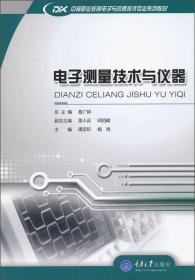

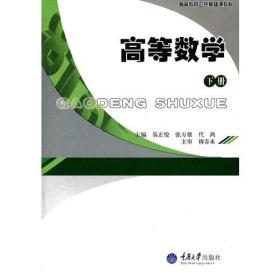
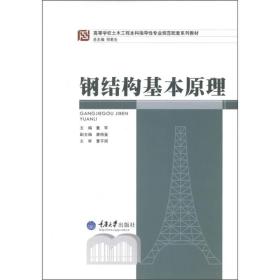



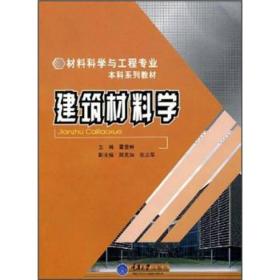
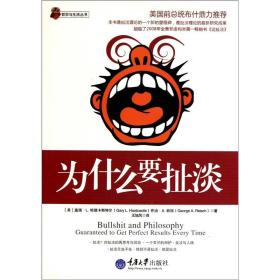

以下为对购买帮助不大的评价